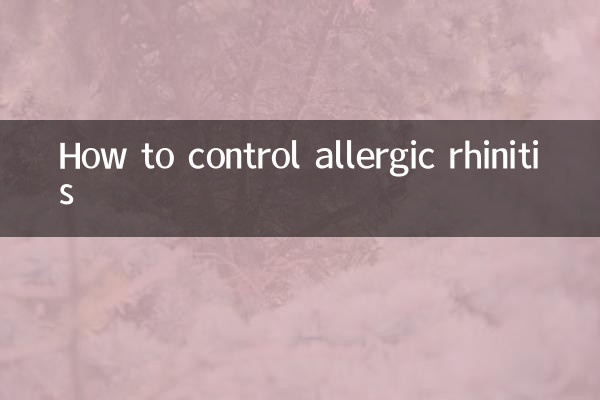How to control allergic rhinitis
Allergic rhinitis is a common allergic disease, mainly characterized by symptoms such as nasal congestion, runny nose, sneezing and nasal itching. With environmental pollution and climate change, the incidence of allergic rhinitis is increasing year by year. This article will combine the hot topics and hot content on the Internet in the past 10 days to provide you with a detailed guide to controlling allergic rhinitis.
1. Common symptoms of allergic rhinitis

Symptoms of allergic rhinitis vary from person to person, but the following are the most common manifestations:
| symptom | describe |
|---|---|
| nasal congestion | Nasal congestion, causing difficulty breathing |
| runny nose | Watery nasal discharge, large amount |
| sneeze | Sneezing multiple times in a row, especially in the morning |
| Itchy nose | Itching in the nasal cavity, which may be accompanied by itching of the eyes |
2. Main causes of allergic rhinitis
Understanding the triggers of allergic rhinitis can help you better prevent and control the condition. The following are common allergens:
| allergens | illustrate |
|---|---|
| pollen | High pollen concentrations in spring and autumn can easily trigger allergies |
| dust mites | Common allergens found in the home environment, especially mattresses and carpets |
| pet dander | Dander and hair from cats, dogs and other pets |
| Mold | Mold spores that grow in moist environments |
3. Control methods of allergic rhinitis
Controlling allergic rhinitis requires a multi-faceted approach, including allergen avoidance, medication, and lifestyle modifications.
1. Avoid allergens
Reducing exposure to allergens is the first step in controlling allergic rhinitis. Here are some practical suggestions:
| method | Specific measures |
|---|---|
| Reduce going out during pollen season | Close windows and use an air purifier |
| Clean your home regularly | Use anti-mite bed covers and wash sheets weekly |
| Keep pets out of the bedroom | Bathe your pet regularly to reduce dandruff |
| Control indoor humidity | Use a dehumidifier to prevent mold growth |
2. Medication
Medication can effectively relieve the symptoms of allergic rhinitis. The following are commonly used types of medications:
| drug type | effect | Common medicines |
|---|---|---|
| antihistamines | Relieve sneezing, itchy nose and runny nose | Loratadine, Cetirizine |
| Nasal corticosteroids | Reduce nasal congestion and inflammation | budesonide, fluticasone |
| Decongestant | Short-term relief of nasal congestion | pseudoephedrine |
| leukotriene receptor antagonist | Reduce inflammatory response | Montelukast |
3. Lifestyle adjustments
Symptoms of allergic rhinitis can be further reduced by making lifestyle adjustments:
| Adjust content | specific suggestions |
|---|---|
| diet | Increase foods rich in vitamin C and Omega-3, such as citrus fruits and deep-sea fish |
| sports | Moderate exercise to boost immunity, but avoid outdoor exercise when pollen concentrations are high |
| sleep | Ensure adequate sleep and improve body resistance |
| psychological adjustment | Reduce stress and avoid mood swings that aggravate symptoms |
4. Preventive measures for allergic rhinitis
The key to preventing allergic rhinitis is to reduce exposure to allergens and strengthen your own immunity. Here are some prevention tips:
| Precautions | Specific methods |
|---|---|
| Regular cleaning | Vacuum carpets and furniture to reduce dust mites |
| Wear a mask | Wear a mask when going out during pollen season or when pollution is high |
| Immunotherapy | Perform desensitization treatment under the guidance of a doctor to relieve allergy symptoms in the long term |
| Enhance immunity | Eat a balanced diet, exercise moderately, and maintain good living habits |
5. Summary
Although allergic rhinitis cannot be completely cured, scientific control methods can effectively relieve symptoms and improve quality of life. The key is to avoid allergens, use medications wisely, and adjust your lifestyle. If your symptoms are severe or have not been relieved for a long time, it is recommended to seek medical treatment in time and seek professional help.

check the details

check the details